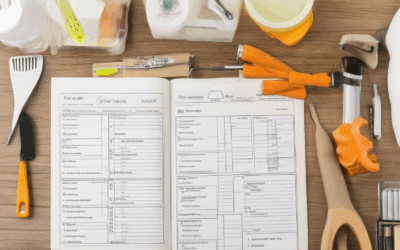Transforming your home into a space that truly reflects your style and personality can be both exciting and challenging. Whether you’re tackling a small repair or embarking on a full-scale renovation, having a well-prepared plan is essential for success. This guide offers a comprehensive approach to your DIY home project, ensuring you stay organized, on budget, and on track. From understanding the 30% rule in home renovation to learning how to prioritize tasks and maximize your home’s value, we’ve got you covered. Discover the secrets to planning a renovation, drafting precise plans, and staying motivated throughout your project. With our essential checklist and expert tips, you’ll be equipped to take on any DIY challenge with confidence. Let’s dive in and unlock the potential of your home!
Final Answer:
Creating a successful DIY home project involves a thoughtful approach, combining planning, organization, and a willingness to seek help when needed. Here’s a structured plan based on the considerations:
1. Define Your Goals
- Clearly outline what you aim to achieve, whether it’s a bathroom remodel or a deck addition.
- Discuss your vision with family or roommates to ensure everyone’s preferences are considered.
2. Set a Realistic Budget
- Research average costs for materials and labor, comparing quotes from suppliers and contractors.
- Allocate funds for unexpected expenses and consider DIY tasks to reduce costs.
3. Plan Your Design
- Gather inspiration from online sources, magazines, or home improvement shows.
- Measure the space and consult with a friend or professional for layout ideas.
- Sketch a rough design using tools like paper or CAD software for clarity.
4. Secure Necessary Permits
- Contact local authorities to obtain permits, ensuring compliance with zoning laws and building codes.
- Visit town halls or government websites for specific requirements.
5. Hire Trusted Professionals When Needed
- For tasks requiring expertise, interview and vet contractors, checking portfolios and references.
- Seek professional help for electrical work, plumbing, or complex designs.
6. Develop a Detailed Timeline
- Use project management tools or apps to track progress and deadlines, even if you’re not tech-savvy.
- Break tasks into manageable phases to avoid delays.
7. Prioritize Safety Measures
- Implement safety protocols, such as temporary fencing and careful handling of electrical systems.
- Watch safety videos or read guides to prevent accidents.
8. Monitor Budget Closely
- Track every expense meticulously, adjusting the budget as needed.
- Set aside contingency funds for unforeseen costs.
9. Effective Communication
- Hold regular meetings or use communication tools to update stakeholders.
- Maintain clear and timely interactions to avoid misunderstandings.
10. Finalize and Review
- Conduct final inspections to ensure quality and compliance.
- Resolve any lingering issues and secure warranties or guarantees.
11. Enjoy Your New Space
- Appreciate the finished project, sharing your accomplishment with others.
- Document the journey for personal reflection and future inspiration.
Additional Tips:
- Seek Local Resources: Engage with community forums or attend workshops for insights and advice.
- Balance Time Commitment: Assess the project’s complexity against your schedule to avoid burnout.
- Ask for Help When Needed: Don’t hesitate to enlist professionals for challenging tasks to ensure safety and quality.
By following these steps, you can confidently embark on your DIY project, knowing you’ve covered the essential aspects for a successful outcome.

Understanding the 30% Rule in Home Renovation
The 30% rule in home renovation is a crucial guideline that helps determine how much you can safely spend on improvements based on your home’s current market value. Here’s a breakdown of what it entails:
- Definition:** The 30% rule states that your renovation budget should not exceed 30% of your home’s estimated market value. This ensures that your investments align with your property’s potential value.
- Why It Matters:** This rule helps prevent overspending. If your home is worth $300,000, you’d want to allocate no more than $90,000 on renovations.
- Key Considerations:**
- Focus on upgrades that offer the best return on investment, such as kitchen remodels or smart home technology.
- Work with a trusted contractor or designer to stay within budget and ensure quality workmanship.
- Plan for unexpected costs by setting aside a contingency fund.
Examples of the 30% Rule in Action
Consider two scenarios:
- Mid-Range Renovation:** A $250,000 home could allow for a $75,000 renovation, focusing on functional upgrades like new appliances or flooring.
- High-End Upgrade:** A $500,000 property might justify a $150,000 renovation, enabling luxury additions like a gourmet kitchen or a spa-like bathroom.
Best Practices for Staying Within Budget
To maximize the effectiveness of your renovation while adhering to the 30% rule:
- Research materials and labor costs beforehand.
- Prioritize energy-efficient upgrades that may qualify for tax incentives.
- Document all changes for potential resale value.
Common Mistakes to Avoid
Many homeowners overlook the 30% rule, leading to costly overspending. Avoid:
- Over-improving for personal preference without considering resale value.
- Underspending and missing out on valuable upgrades.
- Ignoring long-term maintenance needs that affect overall value.
By understanding and applying the 30% rule thoughtfully, you can create a home that enhances both your lifestyle and its market appeal, all while staying within a sensible budget.
For more insights, explore our guide on Assessing Your Home’s Value and our Budgeting Tips for Renovations .
In What Order Should I Renovate My House?
To ensure your home renovation is done efficiently and effectively, follow this organized approach:
- Foundation and Structural Repairs
Begin by assessing and addressing any issues with your home’s foundation. Inspect for cracks, uneven surfaces, or signs of wear. Repair foundational problems early to prevent more severe issues later. Consider hiring a professional for accurate evaluations and reliable fixes. - Plumbing and Electrical Systems
Next, inspect and repair your plumbing system to prevent leaks and water damage. Check pipes for rust or corrosion and ensure proper water flow. Concurrently, have a qualified electrician examine circuits, outlets, and wiring to guarantee safety and functionality. - Roofing and Window Replacement
Replace outdated or damaged roofing material to protect against water infiltration and improve energy efficiency. Install high-quality, energy-efficient windows to enhance insulation and reduce heat loss. - Walls and Flooring
Once structural elements are in place, focus on interior surfaces. Paint or plaster walls and replace old or warped flooring with durable materials. This step ensures a stable and visually appealing living space. - Decorating and Finishing Touches
Finally, personalize your home with decorative elements like paint colors, flooring choices, and soft furnishings. Complete the renovation by landscaping the yard and planting trees or shrubs to boost curb appeal.
By following this sequence, you prioritize structural integrity, safety, and aesthetics, ensuring a comprehensive and successful renovation process.

Do DIY Projects Increase Home Value?
Yes, DIY projects can significantly enhance your home’s value. Whether you’re planning to sell or simply wanting to improve your living space, investing time and effort into home improvements can yield long-term benefits.
- Painting: Refreshing walls and ceilings with a fresh coat of paint can boost curb appeal and increase property value by up to 50%.
- Fixtures Update: Replacing outdated lighting fixtures, faucets, and hardware can modernize your space and leave a lasting impression on potential buyers.
- Landscaping: Enhancing your yard with new plants, a garden bed, or a patio can drastically improve your home’s exterior appearance and overall value.
- Bathrooms and Kitchens: Small remodels in these high-impact areas can add substantial value. Consider updating tiles, fixtures, or cabinetry.
When tackling DIY projects, consider the following:
- Scope and Budget: Focus on manageable projects within your skill level and budget. Overambition can lead to costly mistakes or incomplete work.
- Quality Materials: Use durable materials to ensure your improvements last. Poor-quality choices may reduce long-term value.
- Permits and Zoning: Check local regulations before starting any structural changes to avoid legal issues later.
By taking on DIY projects thoughtfully, you can enjoy a more beautiful and valuable home while saving money compared to hiring professionals. Start small and build confidence with each successful project!

How to Plan a Home Remodeling Project
To effectively plan a home remodeling project, follow these organized steps:
- Define Your Goals
- Set Your Budget
- Plan Your Design
- Secure Necessary Permits
- Hire Trusted Professionals
- Develop a Timeline
- Ensure Safety Measures
- Monitor Budget Closely
- Communicate Effectively
- Finalize and Review
- Enjoy Your New Space
Identify the primary objectives of your remodel, whether it’s updating a specific area, expanding your living space, or improving functionality.
Create a detailed budget considering materials, labor costs, and unexpected expenses. Research average prices and compare quotes from suppliers and contractors.
Sketch out your desired layout or gather inspiration from design magazines and online platforms. Consider consulting an architect or interior designer for professional guidance.
Contact local authorities to obtain required permits for your project. Early approval ensures compliance and avoids delays.
Interview and select reputable contractors, architects, and designers. Check their portfolios, request client testimonials, and verify licensing and insurance.
Estimate the duration of each phase, from demolition to completion. Use project management tools or apps to track progress and deadlines.
Implement safety protocols, such as temporary fencing and careful handling of electrical systems. Plan for waste management to keep your workspace tidy.
Regularly review expenses and adjust your budget as needed. Set aside contingency funds for unforeseen challenges or changes.
Hold regular meetings with your team to discuss progress and address any concerns. Maintain clear communication to avoid misunderstandings.
Conduct a final walkthrough to confirm all tasks are completed satisfactorily. Resolve any lingering issues and secure warranties or guarantees from your contractors.
Once everything is in order, enjoy the fruits of your labor. Reflect on the remodel’s success and consider future improvements based on your experience.
How to Start a House Project
To begin a house project, follow these organized steps:
- Plan and Prepare
- Conduct a property survey to determine boundaries and ensure compliance with local regulations.
- Consult with local building codes to understand zoning laws, height restrictions, and permit requirements.
- Secure funding through loans, savings, or alternative financing options like construction loans.
- Engage a general contractor to oversee the project.
- Enlist an architect or designer to create a custom floorplan and finalize the design.
- Interview and select a landscape designer for outdoor enhancements.
- Collaborate on the design with family members to ensure everyone’s preferences are considered.
- Apply for necessary permits and submit all required documentation for approval.
- Clear and level the land as needed.
- Install necessary utilities and ensure access to water, electricity, and septic systems.
- Research and choose a reputable builder based on reviews, portfolios, and referrals.
- Review and sign detailed contracts, including change orders to accommodate modifications.
- Utilize project management tools to track progress, budgets, and deadlines.
- Set milestones and maintain regular communication with all parties involved.
- Keep digital records of all project documents and photos for easy access.
- Create a detailed budget covering land acquisition, labor, materials, and future maintenance costs.
- Stick to the budget by prioritizing essential elements and considering cost-saving measures without compromising quality.
- Schedule regular building inspections to ensure compliance with local codes and safety standards.
- Conduct a final walkthrough to verify that all aspects of the project meet expectations.
- Receive and review handover documents for property transfer.
- Focus on landscaping and interior finishing touches to complete the project.

Steps to Create a Remodel Plan
- 1. Gather Requirements: Start by understanding what you want to change. Discuss your goals and needs with your family or roommates. Determine which areas need improvements and what features you’d like to add or modify.
- 2. Get Design Inspiration: Look at photos online, magazines, or home improvement shows to gather ideas. Note down the elements you like and how you can incorporate them into your space.
- 3. Create a Sketch: Draw a rough draft of your remodel plan on paper or use digital tools like CAD software to visualize the changes. Include measurements and labels for accuracy.
- 4. List Tools and Materials: Identify the tools and materials needed for the project. Create a checklist to ensure nothing is missed during the remodel.
- 5. Budget Planning: Set aside a budget for the remodel. Research average costs for materials, labor, and services. Compare prices from different suppliers to find the best deals.
- 6. Hire Professional Help: Consider hiring a contractor or designer to assist with the planning and execution. They can provide valuable insights and ensure the remodel meets local building codes.
Conclusion
A well-planned remodel can transform your home into a more functional and beautiful space. By following these steps, you’ll create a clear roadmap for success. Remember to stay organized and flexible as you navigate the remodeling process.




0 Comments